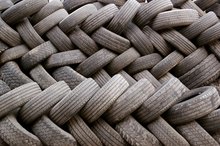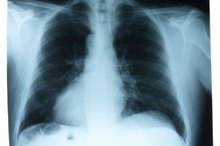What does fact checked mean?
At Healthfully, we strive to deliver objective content that is accurate and up-to-date. Our team periodically reviews articles in order to ensure content quality. The sources cited below consist of evidence from peer-reviewed journals, prominent medical organizations, academic associations, and government data.
The information contained on this site is for informational purposes only, and should not be used as a substitute for the advice of a professional health care provider. Please check with the appropriate physician regarding health questions and concerns. Although we strive to deliver accurate and up-to-date information, no guarantee to that effect is made.
Allergic Reactions to Concrete Dust
Making concrete involves mixing dry cement, which is known by the generic term portland cement, with water. Pouring dry cement out of bags generates dust. That dust contains hexavalent chromium, a compound that irritates the skin and produces burns and rashes. Beyond the immediate dangers from handling cement and inhaling its dust, long-term effects include the development of allergic reactions.
If you are experiencing serious medical symptoms, seek emergency treatment immediately.
Hexavalent Chromium
Hexavalent chromium is a toxin that is harmful to the skin. It is classified as a potential occupational carcinogen by the NIOSH, or National Institute for Occupational Safety and Health. In addition to an increased risk for lung cancer, the Centers for Disease Control and Prevention (CDC) lists other health effects as occupational asthma, nasal irritation, respiratory irritation and nosebleeds 2. It creates a larger danger when the cement is wet as opposed to dry, but dry dust still is harmful to workers and anyone exposed.
- Hexavalent chromium is a toxin that is harmful to the skin.
- In addition to an increased risk for lung cancer, the Centers for Disease Control and Prevention (CDC) lists other health effects as occupational asthma, nasal irritation, respiratory irritation and nosebleeds 2.
Skin Allergies
Bird Allergy Symptoms
Learn More
Skin allergies result from allergic reactions to hexavalent chromium or chromium itself. These allergies affect the skin causing rashes and skin ulcers to develop. Exposure to concrete dust occurs over time; many workers will not exhibit any skin allergies for years only to have a reaction develop suddenly. Once an allergy occurs, the amount of dust necessary to trigger the reaction gradually lessens. At some point, only the smallest amount will cause the reaction; at that point, the worker's allergy is lifelong. He can never work with cement and concrete again.
- Skin allergies result from allergic reactions to hexavalent chromium or chromium itself.
- Exposure to concrete dust occurs over time; many workers will not exhibit any skin allergies for years only to have a reaction develop suddenly.
Occupational Asthma
Hexavalent chromium causes an allergy known as occupational asthma. Symptoms include difficulty breathing and wheezing. Its cause is the long-term exposure to dry cement dust. It begins with irritation to the nose, mouth and lungs. Difficulty breathing and a cough develop in later stages. It resembles asthma but is caused by the dust.
- Hexavalent chromium causes an allergy known as occupational asthma.
- It resembles asthma but is caused by the dust.
Precautions
Toxic Vapors Emitted From New Tires
Learn More
Precautions to avoid developing allergies and to contain active ones include wearing a good pair of alkali resistant gloves along with long-sleeved shirts and long pants. Pull sleeves over gloves and tuck pants inside boots. Wear waterproof boots to avoid contact with wet cement. Wear goggles with side shields to keep dust out of the eyes. Wear respiratory equipment when exposed to cement dust, either from bags of dry cement or broken pieces of concrete. Keep adequate ventilation in work areas.
- Precautions to avoid developing allergies and to contain active ones include wearing a good pair of alkali resistant gloves along with long-sleeved shirts and long pants.
- Wear waterproof boots to avoid contact with wet cement.
Related Articles
References
- United States Department of Labor: Preventing Skin Problems From Working With Portland Cement
- Centers for Disease Control and Prevention: Hexavalent Chromium
- U.S. Department of Labor: Portland Cement (Total Dust)
- Construction Safety Magazine; Cement Hazards And Controls Health Risks And Precautions In Using Portland Cement; Dru Sahai, Summer 2001
- Nelson HS. Immunotherapy for house-dust mite allergy. Allergy Asthma Proc. 2018;39(4):264-272. doi:10.2500/aap.2018.39.4145
- Kim JY, Rhee CS, Cho SH, Choe G, Kim DY, Han DH. House dust mite sublingual immunotherapy in children versus adults with allergic rhinitis. Published online ahead of print, 2020 Jun 13. Am J Rhinol Allergy. 2020;1945892420931713. doi:10.1177/1945892420931713
- Asthma and Allergy Foundation of America. Dust mite allergy. Updated October 2015.
- Babe KS Jr, Arlian LG, Confer PD, Kim R. House dust mite (Dermatophagoides farinae and Dermatophagoides pteronyssinus) prevalence in the rooms and hallways of a tertiary care hospital. J Allergy Clin Immunol. 1995;95(4):801-805. doi:10.1016/s0091-6749(95)70121-4
- Illinois Department of Public Health. Mites affecting humans.
- Lee E, Lee SY, Park MJ, Hong SJ. TNF-α (rs1800629) polymorphism modifies the effect of sensitization to house dust mite on asthma and bronchial hyperresponsiveness in children. Published online ahead of print, 2020 May 20. Exp Mol Pathol. 2020;115:104467. doi:10.1016/j.yexmp.2020.104467
- Boberg E, Johansson K, Malmhäll C, Weidner J, Rådinger M. House Dust Mite Induces Bone Marrow IL-33-Responsive ILC2s and TH Cells. Int J Mol Sci. 2020;21(11):E3751. Published 2020 May 26. doi:10.3390/ijms21113751
- Weitzel T, Makepeace BL, Elliott I, Chaisiri K, Richards AL, Newton PN. Marginalized mites: Neglected vectors of neglected diseases. PLoS Negl Trop Dis. 2020 Jul 23;14(7):e0008297. doi: 10.1371/journal.pntd.0008297. PMID: 32701946; PMCID: PMC7377360.
- Atta AH, Amer RM, Mesbah AE, Khater MW. Sublingual Versus Subcutaneous Immunotherapy as regards Efficacy and Safety in Respiratory Allergic Patients. Egypt J Immunol. 2019;26(2):65-78.
- American Lung Association. Dust mites. Updated July 1, 2019.
Writer Bio
Robert Alley has been a freelance writer since 2008. He has covered a variety of subjects, including science and sports, for various websites. He has a Bachelor of Arts in economics from North Carolina State University and a Juris Doctor from the University of South Carolina.









